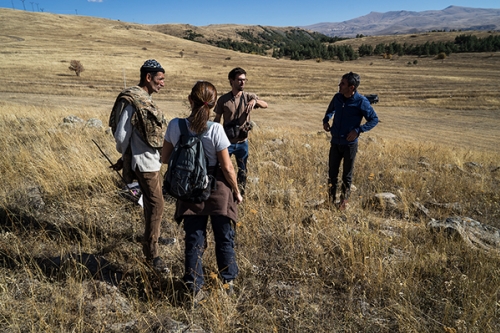

EcoLur
Balkani Wildlife Society experts have revealed new factors of Amulsar project impact on the wildlife to support the implementation of Chapter 3 (Environment) of СЕРА signed between the EU and the Republic of Armenia. The examination has been supported by CEE Bankwatch and EcoLur Informational NGO. The examinations were carried out in October-November 2018 with the participation of Andrey Ralev, Andrey Kovatchev, Elena Tsingarska-Sedefcheva, all being the members of Balkani Wildlife Society.
In his interview with EcoLur, Andrey Ralev presented the main conclusions of the Report on New Circumstances Related to the Environmental and Social Impact Assessment (ESIA) of the Amulsar Gold Project in Armenia.
In reply to the question on the new circumstances, Andrey Ralev said, “We’ve found five new circumstances: the most important one is that the EIA of Amulsar project is missing the assessment, which would have complied with the requirements of the Berne Convention on the Conservation of European Wildlife and Natural Habitats ratified by Armenia in 2008.
The fact is that a part of the territory of Amulsar area is inside the territory of the “Djermuk Area” AM0000009 ASCI.

The Emerald site is under the protection of the Berne Convention, as Armenia, on an international level, determined it as an Area of Special Conservation Interest, which means that Armenia shall take all efforts to conserve the nature, habitat and species in the confirmed list of the Berne Convention. In case of Amulsar project, it means that the EIA of Lydian should have examined the species inhabiting on Emerald sites and incorporated into the lists of the convention and give appraisal what percentage of these species would remain after the implementation of the project. This hasn’t been carried out at all.
The EIA also doesn’t say anything about “Jermuk” Emerald site, as well as anything about other neighboring Emerald sites – “Gorhajk Area” (AM0000013), "Gnishik Protected Landscape” (AM0000012), “Tatev Area” (AM0000016) and "Sevan National Park” (AM0000002). The examinations in the neighboring sites shall determine, whether there is an impact, for example, through the Arpa and Vorotan Rivers etc.
The second circumstance concerns the methodology used in drawing up the EIA, which doesn’t comply with the requirements of the Berne Convention. For example, the EIA has the definition of a critical habitat only for one species of the Berne Convention – the brown bear, nevertheless, it misses criteria for other 30 species protected by the Berne Convention.
The third circumstance is connected to the methodology of the compensation for the damage caused to the biodiversity in the view of establishing Jermuk National Park. Under the Berne Convention, it is impermissible to eliminate nature on one spot and to create on another one. It is not permitted as the Convention prescribes if there are Emerald sites, they shall be entirely conserved by the government and not the business.
In order for Jermuk to be confirmed as an Emerald site, the Armenian experts on the biodiversity had submitted well-prepared information on biodiversity based on which one may say that Amulsar project, besides the brown bear, has an impact on 301 more species and 11 natural habitats. For example, we have found information on seeing leopard here, while Armenia has taken commitments on the recovery of these species, while the EIA doesn’t say anything about the leopard and its habitat at all. The same is true about the Armenian mouflon.”

In reply to the question what he thinks about Apollo butterfly, Andrey Ralev said, “The EIA of the company mentions plants, which are reproduction spots for this butterfly. In accordance with the Berne Convention, a habitat is not only the area where these species reproduce but also feed, move etc so we can consider that the butterfly lives in this environment.”
He also pointed out the new circumstance, “In June 2018, the Arpa River was contaminated with the leaks from the HLF of Amulsar project. In its letter to Environmental Inspection, the Company admitted this fact explaining it with heavy precipitation. Nevertheless, this problem, this risk for water and fish and other species inhabiting in the river haven’t been assessed in the EIA. A question arises, if a leak happened because of heavy rainfalls, what may happen with the Arpa River in case different emergencies occur. That is, the impact of cyanide production on the Arpa River must be given in a mandatory manner, especially, taking into consideration the fact of catastrophes having occurred with cyanide production. In 2000, the cyanide leaked into the Tisza River in Baia Mare, Romania, and this disaster was recognized as the second most horrible one for Europe after Chernobyl. In 1998, a truck with 20 tons of sodium cyanide crashed and fell into the Barskoon River, Kyrgyzstan. As a result of the accident, some 1700 - 1800 kg of sodium cyanide (NaCN) was released directly into the river causing the contamination of the river.”
The experts think that a new EIA shall be submitted which will specify the requirements of the Berne Convention and the newly detected circumstances will receive their relevant assessment.
You can the full report here
Photo: Andrey Ralev
November 09, 2018 at 16:43
